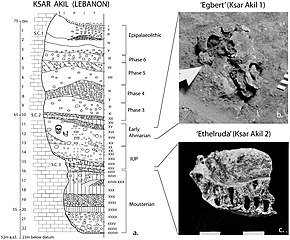
Back Левантийски коридор Bulgarian کریدور شام Persian Koridor Levant ID Левантийский коридор Russian Levanten koridoru Turkish


| The Neolithic |
|---|
| ↑ Mesolithic |
| ↓ Chalcolithic |
The Levantine corridor is the relatively narrow strip in Western Asia, between the Mediterranean Sea to the northwest and deserts to the southeast, which connects Africa to Eurasia. This corridor is a land route of migrations of animals between Eurasia and Africa. In particular, it is believed that early hominins spread from Africa to Eurasia via the Levantine corridor and Horn of Africa.[2] The corridor is named after the Levant.
- ^ a b Higham, Thomas F. G.; Wesselingh, Frank P.; Hedges, Robert E. M.; Bergman, Christopher A.; Douka, Katerina (2013-09-11). "Chronology of Ksar Akil (Lebanon) and Implications for the Colonization of Europe by Anatomically Modern Humans". PLOS ONE. 8 (9): e72931. Bibcode:2013PLoSO...872931D. doi:10.1371/journal.pone.0072931. ISSN 1932-6203. PMC 3770606. PMID 24039825.
- ^ N. Goren-Inbar, John D. Speth (eds.), "Human Paleoecology in the Levantine Corridor". 1994, ISBN 1-84217-155-0 (book review)
© MMXXIII Rich X Search. We shall prevail. All rights reserved. Rich X Search